How Twitter Users Can Generate Better Ideas
New research suggests that employees with a diverse Twitter network — one that exposes them to people and ideas they don’t already know — tend to generate better ideas.
Topics
Innovations never happen without good ideas. But what prompts people to come up with their best ideas? It’s hard to beat old-fashioned, face-to-face networking. Even Steve Jobs, renowned for his digital evangelism, recognized the importance of social interaction in achieving innovation. In his role as CEO of Pixar Animation Studios (a role he held in addition to being a cofounder and CEO of Apple Inc.), Jobs instructed the architect of Pixar’s new headquarters to design physical space that encouraged staff to get out of their offices and mingle, particularly with those with whom they normally wouldn’t interact. Jobs believed that serendipitous exchanges fueled innovation.1
A multitude of empirical studies confirm what Jobs intuitively knew.2 The more diverse a person’s social network, the more likely that person is to be innovative. A diverse network provides exposure to people from different fields who behave and think differently. Good ideas emerge when the new information received is combined with what a person already knows. But in today’s digitally connected world, many relationships are formed and maintained online through public social media platforms such as Twitter, Facebook and LinkedIn. Increasingly, employees are using such platforms for work-related purposes.3
Studying Twitter Networks
Can Twitter make employees more innovative? In particular, does having a greater diversity of virtual Twitter connections mean that good ideas are more likely to surface, as in the face-to-face world? To answer this question, we used a technique called organizational network analysis (ONA) to create visual representations of employee Twitter networks. We studied ten employee groups across five companies in a range of industries. (See “About the Research.”)
For example, EMC Corporation, a leading company in the information storage and infrastructure industry that is based in Hopkinton, Massachusetts, was one of the companies we studied. We analyzed hundreds of ideas submitted by EMC employees as part of their internal idea management system and correlated that behavior with Twitter usage. Here’s what we found.
First, Twitter users and non-users generally submitted the same number of ideas. However, the ideas of Twitter users were rated significantly more positively by other employees and experts than the ideas of non-users. Raters could only see the ideas themselves, not who submitted them. The anonymity prevents raters from making judgments based on the source of an idea instead of on its intrinsic merit.
Second, in analyzing the structure of each employee’s Twitter network, we found that there was a positive relationship between the amount of diversity in one’s Twitter network and the quality of ideas submitted. However, Twitter activity and size measures (such as the number of tweets, number of followers and number of people followed) were not correlated with personal innovation.
Comparing Two Twitter Networks
Although employees A and B follow approximately the same number of Twitter accounts, A’s network is far more diverse than B’s. For the most part, the people employee A follows are not following each other, which is more conducive to innovation and better idea generation. Compact Twitter networks like employee B’s provide redundant information and are less conducive to ideation.
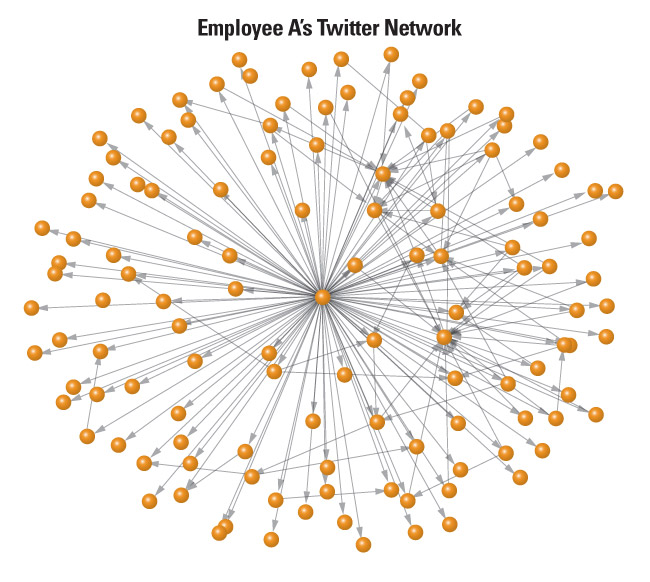
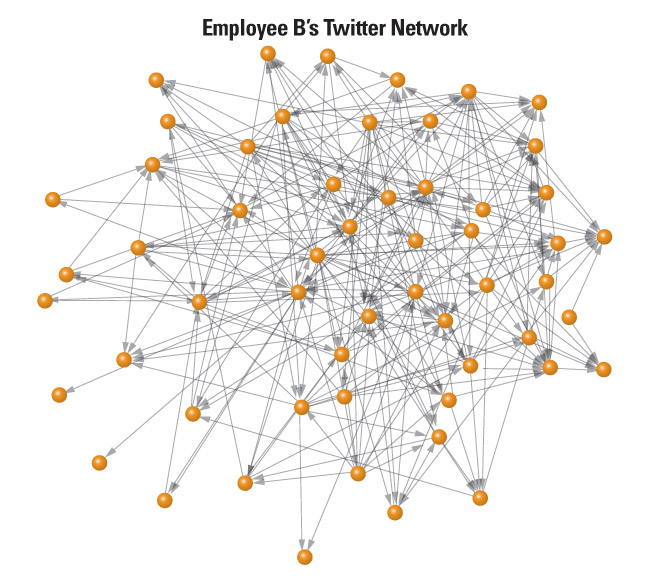
We can explain these findings further by examining the Twitter sociograms of two EMC employees. (See “Comparing Two Twitter Networks.”) In the diagrams, circles represent Twitter users, and an arrow from one user to another user indicates that the first user is following the second user on Twitter. Even though both employees A and B follow approximately the same number of Twitter accounts, A’s network is far more diverse than B’s. That is to say, the people whom employee A follows on Twitter are, for the most part, not following each other. We can determine this level of diversity mathematically by using the compactness ratio, which measures the degree to which people in the network are connected to each other. For employee A, the network’s compactness ratio is quite low, at 18%. Our research found that loose Twitter networks, such as employee A’s, are better for ideation, because the potential for accessing a divergent set of ideas is greater. By contrast, employee B’s Twitter network is compact: People in employee B’s network mostly follow each other, resulting in a compactness ratio of 82%. Such cohesive networks provide more redundant information, which our research shows is negatively correlated with ideation. What’s more, although we’re using EMC as an example in this article, we found similar results in the other companies we studied, suggesting these general findings are not specific to one industry or company.
Idea Scout and Idea Connector
Just exposing oneself to diverse fields, opinions and beliefs on Twitter by itself is not sufficient to enhance innovativeness. Additional capabilities are needed to ensure that the ideas triggered via Twitter can be transformed into actual innovative outcomes. To identify what these complementary capabilities are, we conducted 205 interviews with Twitter users across the ten groups in our sample. Through the interviews, we found that individual absorptive capacity4 — the ability of employees to identify, assimilate and exploit new ideas — is critical for employees to build and learn from their Twitter networks. This means that if you are a Twitter user with the goal of improving your innovation performance, you need to maintain a diverse network while also developing your information assimilation and exploitation skills.
Using Twitter to Spur Innovation
An idea scout is an employee who looks outside the organization to bring in new ideas. An idea connector, meanwhile, is someone who can assimilate the external ideas and find opportunities within the organization to implement these new concepts. In our research, Twitter users who performed the two roles at the same time were the most innovative.
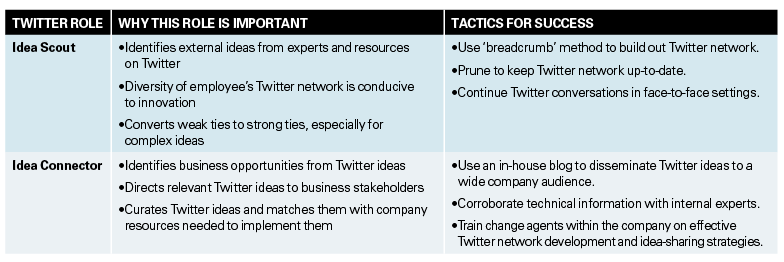
In particular, two activities emerged as being significantly correlated with increasing individual absorptive capacity and personal innovation: “idea scouting” and “idea connecting.” In an earlier paper that two of us coauthored, we defined an idea scout as an employee who looks outside the organization to bring in new ideas. An idea connector, meanwhile, is someone who can assimilate the external ideas and find opportunities within the organization to implement these new concepts.5 In this study, we found that Twitter users who performed the two roles at the same time were the most innovative. (See “Using Twitter to Spur Innovation.”) While the following examples and quotations come from EMC employees (unless otherwise noted), we heard many comments like this across our entire sample. Here are the common themes that emerged from the interviews:
1. Use Twitter to become an idea scout. Several employees described Twitter as a “gateway to solution options” and a way to obtain different perspectives and to challenge one’s current thinking. One engineer, for example, was able to improve the speed of a suite of the company’s products thanks to a tweet from a technology guru about Web app performance; the tweet provided information about when and where bottlenecks were occurring. Other employees leveraged Twitter to obtain best practices from industry experts about customer advocacy programs such as loyalty initiatives. Several others mentioned how they improved personal productivity by following early technology adopters on Twitter to learn about new tools they were using in the workplace.
So who do you follow if your goal is to find quality ideas? Interviewees said you need to be tactical: It’s not the number of people you follow on Twitter that matters; it’s the diversity within your Twitter network. This view was echoed by a senior technologist:
“I don’t necessarily want to follow more people. I just want to follow people whose opinions don’t always align with my own, which is kind of an ongoing battle because after a year or so of following the same people, you find that your opinions shift and morph a little, and suddenly you are with a homogenous group of people again.”
Several employees referred to a “breadcrumb” method to find industry subject-matter experts and influencers on Twitter who will challenge their thinking. After a period of “listening” to colleagues and industry leaders who are on the platform — including what they are tweeting about, who they are following or replying to on the platform, and who is being retweeted often — these employees said they eventually find the people they want to follow and engage with on Twitter. The key is to listen first and then assemble the right people for your Twitter network.
Get Updates on Transformative Leadership
Evidence-based resources that can help you lead your team more effectively, delivered to your inbox monthly.
Please enter a valid email address
Thank you for signing up
One HR professional we interviewed disclosed how she follows a 70/30 rule to blend serendipity into her Twitter network: While 70% of the people she follows are people directly relevant to her work, 30% are outside her comfort zone. The outside portion is designed to challenge her existing beliefs and includes sources not connected to HR. Several employees mentioned virtual connections to the thoughts of individuals such as former astronaut Buzz Aldrin, astrophysicist Neil deGrasse Tyson and science commentator Bill Nye as catalysts for good ideas — even though those individuals were not directly involved with the work the employees were doing.
Several employees spoke about the importance of keeping their Twitter networks up-to-date. A pruning strategy is necessary since people’s topic interests change. Pruning also allows employees to eliminate redundancy. In addition to monitoring their networks for relevancy, employees also monitor the frequency of the tweets of people they follow to determine if they are still active or if they can be removed from the network. Several people we talked to noted that they considered Twitter to be different from email and other information sources in that it enables continuous engagement and conversation with experts. As one community manager commented:
“Twitter allows your battery life to last longer. I will only follow people that will tweet and reply in a timely fashion. So, the people I follow on Twitter have to be social and willing to share, in addition to being an expert or interesting.”
Employees can use Twitter as a way to move from weak ties to strong ties with experts. Although public social platforms are effective at establishing weak ties (in other words, people you are familiar with but do not know well), strong ties are needed to transfer complex product knowledge.6 Engagement on the platform (such as replies, retweets and mentions) often leads to face-to-face meetings. In those cases, Twitter acts as a natural icebreaker. Alternatively, relationships with experts you meet in person or know from your workplace can be extended on Twitter. One engineer explained how a series of Twitter conversations with a software developer at another company led to a face-to-face meeting. Eventually, their relationship gave rise to a rich collaborative effort on several technology projects between the two companies.
Often, the conversations with experts on Twitter are particularly pertinent before and after a face-to-face event such as an industry conference. One engineer commented on the value of engaging with selected colleagues on Twitter before meeting them for the first time at a conference, noting:
“I felt I had known this person for a while, even though we had never met. After reading and replying to his tweets and blog posts, I had done my due diligence.”
2. Use Twitter to be an idea connector. Several employees mentioned how important it is to have a strategy for sharing Twitter content with the appropriate internal stakeholders. They described their roles as listener, curator and alerter. As one employee explained:
“I try to sift through all the Twitter content from my network and look for trends and relationships between topics. I then put my analysis and interpretation on it. I feel that’s where my value-add is. I’m not just sending out a bunch of links. I think through what might be valuable to particular groups such as marketing or engineering. This leads to engaging discussion.”
One Twitter user created a “business analytics” list so he could track various experts on analytics. He filtered specific subsets of the topic for different stakeholders within his group. For example, the marketing team was interested in websites and in-store analytical best practices, tools and ROI metrics. He was able to take the latest findings and translate the material he found to fit that group’s work processes. The HR group, for its part, was interested in talent management analytics, but its understanding of analytics was less developed than the marketing group’s understanding. This meant that in order to be an effective idea connector, he had to be savvy in terms of whom to approach within the HR group — for example, early adopters of new analytical technologies or HR managers receptive to new practices.
Effective Twitter users also understand the importance of disseminating ideas to a broader company audience. Several users mentioned that they create social dashboards or company blogs based on the insights they get from Twitter. One employee at a food products company mentioned:
“I had been following health and fitness expert Twitter accounts. I blogged about some of the latest lifestyle trends and how this might impact how we target millennials. Most of our existing customer base is in the 40- to 70-year-old demographic, who have some different attitudes, knowledge and behaviors towards fitness than millennials. These blogs generated lots of comments and discussion.”
Finding ways to share Twitter content with work colleagues is also critical since many employees, especially baby boomers, don’t use the platform themselves. Other employees mentioned the importance of corroborating the technical information obtained from Twitter with other colleagues to discuss its validity and relevance.
A number of Twitter users were so positive about its potential value that they took it upon themselves to train their colleagues through webinars and one-on-one or small-group sessions on how to use the platform effectively. The training sessions were not solely about the technical aspects of Twitter, which were easy to grasp, but also about ways to increase effective absorptive capacity by identifying relevant external expertise and making it meaningful to company stakeholders so it can be implemented.
References
1. W. Isaacson, “Steve Jobs” (New York: Simon & Schuster, 2011): 431.
2. Ron Burt’s seminal study on structural holes has proven to be influential in explaining how people accrue advantages from their social network. Gaps in a social network, called structural holes, create brokerage opportunities. People on either side of the hole circulate in different flows of information, and benefits accrue to those individuals whose relationships span the structural hole. See R.S. Burt, “Structural Holes: The Social Structure of Competition” (Cambridge, Massachusetts: Harvard Business Press, 1992).
3. See, for example, N.G. Barnes, A.M. Lescault and K.D. Augusto, “LinkedIn Dominates, Twitter Trends and Facebook Falls: The 2014 Inc. 500 and Social Media,” research report conducted by The Center for Marketing Research at the University of Massachusetts Dartmouth, 2015, www.umassd.edu/cmr/socialmediaresearch/2015fortune500andsocialmedia.
4. Coined by Wesley M. Cohen and Daniel A. Levinthal, the term “absorptive capacity” refers to an organization’s ability to assimilate and replicate new knowledge gained from external sources. A substantial body of research demonstrates that absorptive capacity contributes directly and indirectly to company performance. See W.M. Cohen and D.A. Levinthal, “Absorptive Capacity: A New Perspective on Learning and Innovation,” Administrative Science Quarterly 35, no. 1 (March 1990): 128-152.
5. E. Whelan, S. Parise, J. De Valk and R. Aalbers, “Creating Employee Networks That Deliver Open Innovation,” MIT Sloan Management Review 53, no. 1 (fall 2011): 37-44.
6. M.T. Hansen, “Knowledge Networks: Explaining Effective Knowledge Sharing in Multiunit Companies,” Organization Science 13, no. 3 (May-June 2002): 232-248.
i. The supervisor rating questions include: “Please rate your level of agreement with the following statements: (1 =strongly disagree to 6 =strongly agree): (1) This person generates creative work-related ideas. (2) This person promotes and champions work-related ideas to others.” These two items are adapted from: S.G. Scott and R.A. Bruce, “Determinants of Innovative Behavior: A Path Model of Individual Innovation in the Workplace,” Academy of Management Journal 37, no. 3 (June 1994): 580-607.

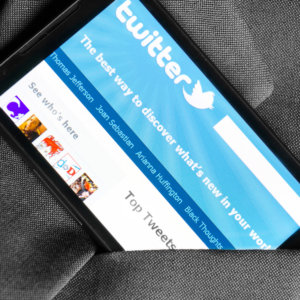
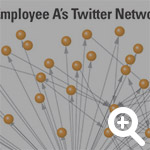 View Exhibit
View Exhibit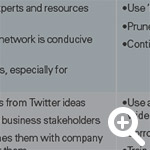 View Exhibit
View Exhibit
Comments (8)
Big Brother
Ricardo Ramos
Adam Garey
Jessica Sullivan
Ralf Lippold
mgjo2012
Jason McPherson
Amarendra Bhushan Dhiraj